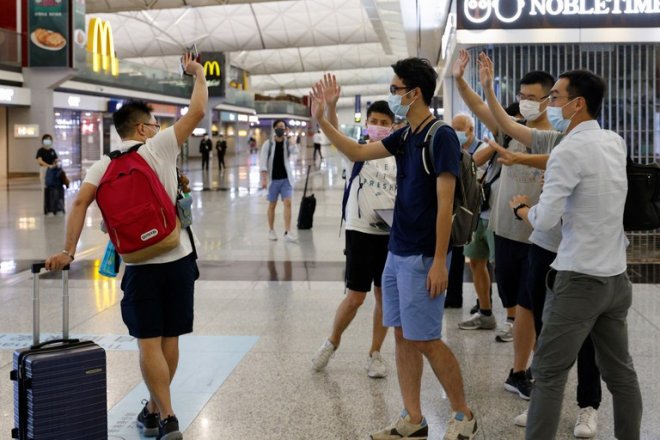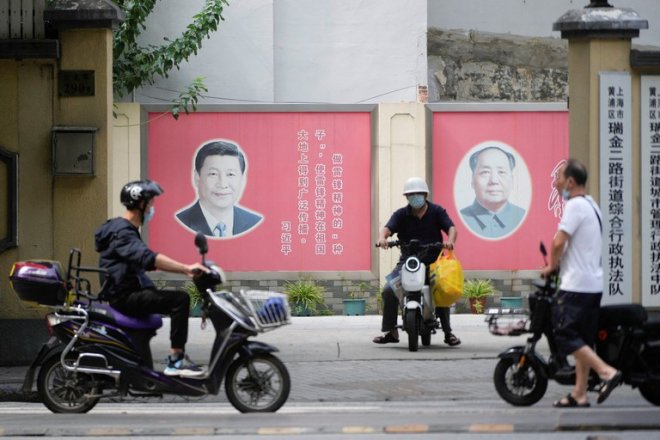Empty containers stack up at major Chinese ports after zero-COVID effect lingers
Major Chinese container ports Shenzhen and Shanghai are seeing a massive growth in the number of empty containers, according to two shipping industry sources, social media footage and a global container tracking website, suggesting a huge slump in manufacturing exports.
Photos of container ports at Shanghai and Shenzhen seen by Radio Free Asia revealed a large number of empty containers stacked up, with remaining storage space for empty containers rapidly dwindling at ports, according to a container ship captain who has worked in the industry for 20 years.
In the week beginning Feb. 27, the Container Availability Index, or CAx, stood at 0.65 when queried for 20-foot dry storage containers -- the most common kind of shipping container -- in the port of Shanghai.
Anything above 0.5 indicates that more containers are entering a port than leaving it, and Shanghai"s score has stood above that level for 45 weeks straight, the index showed.
A query for the eastern port of Qingdao showed the CAx had remained around 0.6 since the start of the year, and hadn"t dropped below 0.5 during the whole of 2022. Shenzhen wasn’t among the cities available on a selection menu for the index.
‘Rollercoaster ride into hell’
Meanwhile, Shanghai"s export container shipping price index stood at U.S.$946.68 on Feb. 24 after a 14-month decline, the lowest point since 2015.
“In the three years since the start of the zero-COVID policy, the entire Chinese shipping industry has gone from normal to stratospheric, before taking a rollercoaster ride into hell," the captain said.
He said that as the initial wave of the COVID-19 pandemic prompted widespread lockdowns around the world, the demand for goods skyrocketed, sending the cost of shipping up four- or fivefold.
But by the start of 2022, as the rest of the world returned to normal levels of activity, costs fell again, and the ruling Chinese Communist Party"s strict enforcement of lockdowns, quarantine and mass testing of the zero-COVID policy dealt a mortal blow to the country"s economy, he said.
It"s a story that has been echoed many times over to Radio Free Asia by economic and legal sources in Shenzhen, amid warnings that a slump at Chinese manufacturers making everything from electronics to clothing is already sparking a wave of labor unrest.
A person in the shipping industry said operators" margins are being squeezed by the massive fall-off in demand for outbound shipping.
"The direction of the flow of goods has reversed," the person said. "I have always said that the Shanghai lockdown was a turning point for China."
"There has been a sharp fall in exports of steel products and complete sets of equipment," the person said. "I used to make more than U.S.$50 [in bulk cargo] per ton, and now it"s a little over nine dollars."
"China"s three years of zero-COVID has been a disaster for the shipping industry, which is now running at massive losses," the person said. "Daily running costs for a 10,000-ton vessel are about U.S.$5,000."
Some production moving to Southeast Asia
He said the Shanghai lockdown in the spring of 2022 in particular had severely damaged economic and business confidence in China.
"For example, the production of steel billets has now been relocated to Vietnam and Indonesia, where new factories have been built," the person said.
"Most of the businesses relocating are owned by domestic capital -- it"s local Chinese businesses that are relocating their manufacturing facilities."
An official who answered the phone at the Shenzhen municipal transportation bureau said the government has fixed prices for the stacking, loading, unloading and lifting of containers.
The lifting fee for a single container is set at 27 yuan, the official said, but declined to comment further.
An employee who answered the phone at Shanghai Port headquarters said the port was operating "normally," and declined to comment on the number of empty containers.
"I don"t have the specific information; we"re not sure about that, OK?" the employee said, before hanging up.
A major freight forwarder told China"s Caixin news site that the return flow of empty containers has mostly been higher than the number of filled containers leaving Chinese ports, and that this has been the case since the fourth quarter of 2022.
Twitter user @JosephZheng777 tweeted on Feb. 21: "Shenzhen Yantian International Container Terminal is empty," adding a video clip of a mostly empty multilane highway, which bore the subtitle "No trucks at the side of the road, and no trucks at the port."
@thestranger515 tweeted a video on Feb. 18, describing it as "Long lines of empty trucks at #Shenzhen Yantian International Container Terminal," before adding: "The Chinese economy is in the Toilet."
Translated by Luisetta Mudie.
[圖擷取自網路,如有疑問請私訊]
Photos of container ports at Shanghai and Shenzhen seen by Radio Free Asia revealed a large number of empty containers stacked up, with remaining storage space for empty containers rapidly dwindling at ports, according to a container ship captain who has worked in the industry for 20 years.
In the week beginning Feb. 27, the Container Availability Index, or CAx, stood at 0.65 when queried for 20-foot dry storage containers -- the most common kind of shipping container -- in the port of Shanghai.
Anything above 0.5 indicates that more containers are entering a port than leaving it, and Shanghai"s score has stood above that level for 45 weeks straight, the index showed.
A query for the eastern port of Qingdao showed the CAx had remained around 0.6 since the start of the year, and hadn"t dropped below 0.5 during the whole of 2022. Shenzhen wasn’t among the cities available on a selection menu for the index.
‘Rollercoaster ride into hell’
Meanwhile, Shanghai"s export container shipping price index stood at U.S.$946.68 on Feb. 24 after a 14-month decline, the lowest point since 2015.
“In the three years since the start of the zero-COVID policy, the entire Chinese shipping industry has gone from normal to stratospheric, before taking a rollercoaster ride into hell," the captain said.
He said that as the initial wave of the COVID-19 pandemic prompted widespread lockdowns around the world, the demand for goods skyrocketed, sending the cost of shipping up four- or fivefold.
But by the start of 2022, as the rest of the world returned to normal levels of activity, costs fell again, and the ruling Chinese Communist Party"s strict enforcement of lockdowns, quarantine and mass testing of the zero-COVID policy dealt a mortal blow to the country"s economy, he said.
It"s a story that has been echoed many times over to Radio Free Asia by economic and legal sources in Shenzhen, amid warnings that a slump at Chinese manufacturers making everything from electronics to clothing is already sparking a wave of labor unrest.
A person in the shipping industry said operators" margins are being squeezed by the massive fall-off in demand for outbound shipping.
"The direction of the flow of goods has reversed," the person said. "I have always said that the Shanghai lockdown was a turning point for China."
"There has been a sharp fall in exports of steel products and complete sets of equipment," the person said. "I used to make more than U.S.$50 [in bulk cargo] per ton, and now it"s a little over nine dollars."
"China"s three years of zero-COVID has been a disaster for the shipping industry, which is now running at massive losses," the person said. "Daily running costs for a 10,000-ton vessel are about U.S.$5,000."
Some production moving to Southeast Asia
He said the Shanghai lockdown in the spring of 2022 in particular had severely damaged economic and business confidence in China.
"For example, the production of steel billets has now been relocated to Vietnam and Indonesia, where new factories have been built," the person said.
"Most of the businesses relocating are owned by domestic capital -- it"s local Chinese businesses that are relocating their manufacturing facilities."
An official who answered the phone at the Shenzhen municipal transportation bureau said the government has fixed prices for the stacking, loading, unloading and lifting of containers.
The lifting fee for a single container is set at 27 yuan, the official said, but declined to comment further.
An employee who answered the phone at Shanghai Port headquarters said the port was operating "normally," and declined to comment on the number of empty containers.
"I don"t have the specific information; we"re not sure about that, OK?" the employee said, before hanging up.
A major freight forwarder told China"s Caixin news site that the return flow of empty containers has mostly been higher than the number of filled containers leaving Chinese ports, and that this has been the case since the fourth quarter of 2022.
Twitter user @JosephZheng777 tweeted on Feb. 21: "Shenzhen Yantian International Container Terminal is empty," adding a video clip of a mostly empty multilane highway, which bore the subtitle "No trucks at the side of the road, and no trucks at the port."
@thestranger515 tweeted a video on Feb. 18, describing it as "Long lines of empty trucks at #Shenzhen Yantian International Container Terminal," before adding: "The Chinese economy is in the Toilet."
Translated by Luisetta Mudie.
[圖擷取自網路,如有疑問請私訊]
|
本篇 |
不想錯過? 請追蹤FB專頁! |
| 喜歡這篇嗎?快分享吧! |
相關文章
AsianNewsCast


















